Atlanta
Roger R. Seapy


This tree diagram shows the relationships between several groups of organisms.
The root of the current tree connects the organisms featured in this tree to their containing group and the rest of the Tree of Life. The basal branching point in the tree represents the ancestor of the other groups in the tree. This ancestor diversified over time into several descendent subgroups, which are represented as internal nodes and terminal taxa to the right.

You can click on the root to travel down the Tree of Life all the way to the root of all Life, and you can click on the names of descendent subgroups to travel up the Tree of Life all the way to individual species.
For more information on ToL tree formatting, please see Interpreting the Tree or Classification. To learn more about phylogenetic trees, please visit our Phylogenetic Biology pages.
close boxIntroduction
Atlanta is the type genus of the family Atlantidae. Both the shell and keel are calcareous. Following metamorphosis the larval shell is retained and becomes the spire of the adult shell. All of the nineteen species but one, A. californiensis, occur in tropical to subtropical waters. The majority of species (ten) are cosmopolitan and among the remaining nine, five are Indo-Pacific, two are restricted to the Pacific Ocean, one is Indo-Atlantic, and one is limited to the Atlantic Ocean.Brief Diagnosis
An atlantid with:
- Shell and keel calcareous
- Larval shell becomes the spire in the adult shell
Characteristics
- Eye morphology of three types: a, b and c (see Atlantidae page)
- Operculum morphology of three types: a, b, c (see Atlantidae page)
- Radular morphology of two types: I and II (see Pterotracheoidea page)
- Shell
- The adult shell consists of three sequentially-deposited regions; a dome-shaped embryonic shell (protoconch I) of about one whorl, a larval shell (protoconch II) of a variable number of whorls, and the adult shell (teleoconch) also of a variable number of whorls.
 Click on an image to view larger version & data in a new window
Click on an image to view larger version & data in a new window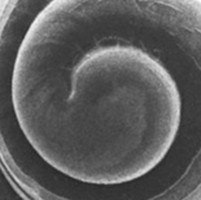
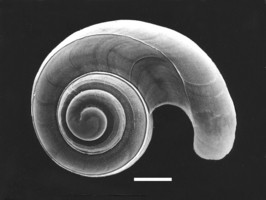
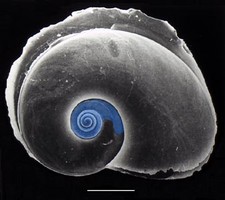
Figure. Scanning electron micrographs of the embryonic portion (protoconch I) of the larval shell (left), the larval shell (protoconch II; middle), and the adult shell (right) in Atlanta plana. In the last SEM the protoconch is shaded blue to distinguish it from the teleoconch. Scale bars = 100 µm (middle) and 0.5 mm (right). © 2005 Roger R. Seapy
- The number of whorls comprising the spire on the right side of the shell is a character that can be very useful in distinguishing species. However, the method of determining the number of spire whorls can be difficult to conceptualize. The total number of whorls that make up an adult shell is usually easy to determine when the shell is viewed under a dissection microscope. In the example of Atlanta plana above, the adult shell can be seen to possess a total of 4-1/4 whorls. Although this total whorl count may be useful as a taxonomic character for describing fully-grown adults, it is variable in all other individuals since the number increases with shell growth. The number of whorls comprising the shell spire, however, is not variable, but rather is predictable because it represents only the larval portion of the adult shell. In late-stage larvae (e.g., see the A. plana larval shell above), the last 1/4 whorl increases noticeably in width by comparison with the preceding whorls. In post-metamorphic shells with raised sculpture on the spire, the junction between the larval shell (protoconch) and the beginning of the adult shell (teleoconch) is often marked by the termination of, or a change in, the sculpture pattern (e.g., see the SEM of the tilted shell spire on the A. brunnea page). Even without the ability to distinguish this point of transition (as is often revealed clearly in SEMs), the point at which the whorl width increases markedly is visible under the dissection microscope. The sketch below of the whorl sutures from an adult A. inflata is used here to describe the method for determining the number of whorls comprising the spire. Note that in practice, the shell is first oriented so that the central embryonic part is directed upward in the field of view. Then, the whorls are counted outward using an imaginary line directed upward (as shown below). In the case of A. inflata, the number of spire whorls at the point of rapid increase in whorl width is 4-1/2. Examples of whorl sketches for two other species, A. lesueurii and A. peronii (from Richter and Seapy, 1999), are shown below for comparison. Spire whorl numbers for the nineteen species of Atlanta (included in the table below) range from two and one-half (in A. lesueurii and A. oligogyra) to six (in A. gibbosa).
 Click on an image to view larger version & data in a new window
Click on an image to view larger version & data in a new window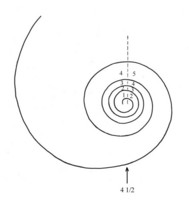
Figure. Sketch of the whorl sutures from Atlanta inflata. The shell is oriented with the embryonic shell directed upward; the whorls are then counted based on an imaginary line directed upward from the center of the embryonic shell. The numbers in the sketch denote the end of one whorl and the beginning of the next one. The arrow indicates the number of whorls (4-1/2) comprising the spire. © 2009 Roger R. Seapy
 Click on an image to view larger version & data in a new window
Click on an image to view larger version & data in a new window
 Click on an image to view larger version & data in a new windowFigure. Sketches of the whorl sutures on the shell spire and extending onto the first adult shell whorl in Atlanta lesueurii (left) and A. peronii (right). The dashed line in each sketch denotes the ending and beginning point for each spire whorl. The arrow at the bottom of each sketch indicates the number of whorls comprising the shell spire. © 2009 Roger R. Seapy
Click on an image to view larger version & data in a new windowFigure. Sketches of the whorl sutures on the shell spire and extending onto the first adult shell whorl in Atlanta lesueurii (left) and A. peronii (right). The dashed line in each sketch denotes the ending and beginning point for each spire whorl. The arrow at the bottom of each sketch indicates the number of whorls comprising the shell spire. © 2009 Roger R. Seapy - The shape of the spire is highly variable among Atlanta species and can often serve as a distinctive character (see below). Examples include the tall, turreted spire of A. turriculata, the conical spire of A. brunnea, and the tilted (or "inclined") spires in the A. inclinata and A. gibbosa species groups.
- In addition to spire shape, spire ornamentation can also be very distinctive; ranging from smooth (e.g., the A. lesueurii species group and three of the members of the A. peronii species group) to ornamented by low, elevated spiral ridges (e.g., A. inflata, A. helicinoidea, and A. plana), to highly ornate and elevated sculpture (e.g., A. brunnea, A. echinogyra and A. turriculata).
- Nineteen species are currently regarded as valid in the genus Atlanta. These species are partitioned into seven species groups (see table below). Tesch (1908) was the first to group together the species of Atlanta sharing similar morphologies. He recognized four species groups; the A. peronii-, A. inflata-, A. turriculata-, and A. inclinata-groups. In addition to these, three additional ones are currently recognized; the A. lesueurii-, A. gaudichaudi- and A. gibbosa groups. Except for Tesch's (1908) A. turriculata-group, the composition of Tesch's species groups has changed by species invalidations, the addition of new species over time, and addition of three new species groups. The main changes in Tesch's species groups have occurred in the A. peronii-group (with A. gaudichaudi and A. lesueurii now forming their own species groups) and the A. inclinata-group (with A. gibbosa now forming its own group).
The geographic distribution of the species in the genus are summarized in the last three columns of the table below. The highest number of species occurs in the Pacific (17), followed by the Indian (16) and the Atlantic (12) Oceans. Ten species are cosmopolitan, recorded from all three major oceans, five (A. turriculata, A. frontieri, A. plana, A. echinogyra, and A.gibbosa) are Indo-Pacific, two (Atlanta inflata and A. californiensis) occur only in the Pacific, one (A. selvagensis) is Indo-Atlantic, and one (A. fragilis) has only been recorded from the Atlantic; no species are unique to the Indian Ocean. It should be noted that one species, A. meteori was previously regarded as Indo-Pacific, but was recorded from the northeastern Atlantic by de Vera, Seapy and Hernandez (2006) and must now be regarded as cosmopolitan.
The seven species groups, their contained species, the distinguishing features of each group and species, and each species' geographic distribution are presented in the table below. The species comprising each species group share the same radular type, usually the same opercular type, and, in many cases, the same eye type. Note that the Group Characteristics are not repeated under the Species Characteristics where they are shared by the members of that Species Group.
| Species Group | Group Characteristics | Species* | Species Characteristics | Maximal Shell Diameter (mm) | Number of Spire Whorls | Eye Type | Opercular Type | Radular Type | Atlantic Ocean | Pacific Ocean | Indian Ocean |
|---|---|---|---|---|---|---|---|---|---|---|---|
| A. brunnea- group | Shell small; keel tall with rounded leading edge; spire tall conical or turreted, sculpted with complex ornamentation and with a prominent, mid-whorl spiral ridge | A. brunnea | Spire tall conical and orange-red color; mantle light black | 2.0 | 4 | a | a | I | + | + | + |
| A. turriculata | Spire tall and turret shaped; spire light brown to red-brown | 1.8 | 4-1/4 | a | a | I | - | + | + | ||
| A. inflata- group | Shell inflated or flat; spire low conical with a large diameter (relative to adult shell size); surface of spire whorls smooth to sculptured with evenly-spaced spiral ridges | A. inflata | Shell inflated; spire low conical with weak to prominent low spiral ridges; spire sutures lack coloration; keel tall with truncate leading edge; keel base brown to yellow-brown | 1.5 | 4-1/4 to 4-1/2 | a | c | I | - | + | - |
| A. selvagensis | Shell inflated; spire low conical with sculpture ranging from none to well-developed and evenly-spaced low spiral ridges; spire sutures red-brown (magenta); keel base brown to yellow-brown | 2 | 3-1/2 to 3-3/4 | a | c | I | + | - | + | ||
| A. helicinoidea | Shell inflated, with body whorl broadly oval to rounded; keel of low to moderate height and rounded; spire with spiral ridges, moderately variable in expression; spire light purple or yellow to yellow-tan | 2 | 4-1/2 to 4-3/4 | c | c | I | + | + | + | ||
| A. californiensis | Shell flattened; keel of moderate height with truncate leading edge and a red- to orange-brown base; spire low conical to globular, and smooth; colorless to uniformly or mottled, light yellow, brown or violet | 3.5 | 3-1/4 | a | c | I | - | + | - | ||
| A. lesueurii- group | Shell spire very small; after larval metamorphosis, only a single and rapidly-expanding last whorl (teleoconch) is formed | A. lesueurii | Shell entirely transparent; spire low and conical with prominent (deep) sutures; keel high, truncate | 6 | 2-1/2 | b | b | I | + | + | + |
| A. oligogyra | Shell faint pink to yellow; spire low and rounded with shallow sutures: keel of moderate height, rounded | 3 | 2-1/2 | a | b | I | + | + | + | ||
| A. peronii- group | Shell flat, of moderate to large size; radula type II, with bicuspid lateral teeth | A. peronii | Shell clear, becoming faintly yellow in large specimens; spire low, rounded; keel of moderate height, with a slightly truncated leading edge and a base that changes from clear to dark yellow-brown with age | 10 | 3-1/2 to 3-3/4 | b | b | II | + | + | + |
| A. fragilis | Shell fragile (very thin-walled), transparent and completely colorless; keel tall with a truncate leading edge and a clear base | 9 | 3-1/2 | b | b | II | + | - | - | ||
| A. rosea | Spire rounded and nearly globular, due to the shallow sutures of first two and one-half whorls; color faintly yellow; species name based on bright pink color of larvae | 5 | 3-1/2 | b | b | II | + | + | + | ||
| A. frontieri | Spire low, with first and second whorls elevated, forming a low cone; distinctive thin, elevated spiral ridge along outer margin of spire whorls; keel tall and rounded; shell clear | 5.5 | 4-1/2 | b | b | II | - | + | + | ||
| A. gaudichaudi- group | Shell flat, with a moderately small maximal size; spire shape low conical; radula type I, with monocuspid lateral teeth | A. gaudichaudi | Spire low conical and surface lacks sculpture; keel of tall, with a truncate leading edge; keel base yellow- or red-brown | 3 | 3-1/4 to 3-1/2 | b | b | I | + | + | + |
| A. plana | Spire low conical with two low spiral ridges on second and third whorls; spire sutures violet; keel moderately low and rounded, with a yellow- or red-brown base; opercular gyre with spiral row of spines | 4 | 3-1/2 | a | b | I | - | + | + | ||
| A. echinogyra | Spire moderately low conical, slightly tilted relative to the shell plane; spire with prominent spiral ridges and red-violet to red-brown color | 2.5 | 3-3/4 | a | c | I | - | + | + | ||
| A.inclinata- group | Shell spire large, with globose shape, and tilted (inclined) relative to shell plane; spire whorls with shallow sutures and numerous small tubercula; internal spire walls decalcified; inner surfaces of spire whorls with radial lines; keel tall and rounded | A. inclinata | Shell clear to light yellow; tubercula scattered on surface of spire | 6-7 | 5 | b | c | II | + | + | + |
| A. tokiokai | Shell light yellow-brown and inside of outer lip of brown; spiral rows of tubercula on spire | 3 | 5-1/2 | b | c | II | + | + | + | ||
| A. gibbosa- group | Shell spire large and tall; shell transparent and colorless, with thin walls; inner surfaces of spire whorls without radial lines; keel tall with truncate leading edge | A. gibbosa | Spire moderately tilted relative to shell plane, with a broad conical shape; umbilicus large and very wide | 4 | 6 | b | b | II | -? | + | + |
| A. meteori | Spire strongly tilted relative to shell plane, with a narrow conical shape; umbilicus small and narrow | 4 | 5-1/2 to 5-3/4 | b | b | II | + | + | + |
*One species, Atlanta peresi, is not included in the table above because it is most probably not valid. It was described by Frontier (1966) from the western Indian Ocean off Madagascar. Although its adult shell morphology and opercular type were characterized by Frontier, its eye and radular morphologies are unknown. Unfortunately, no specimens from Frontier's collections have been found for further examination. Catherine Thiriot (pers. comm. to R. Seapy) had thought that Frontier's collections might have been deposited at the Observatoire Océanologique, Villefranche-sur-Mer, France; but her search for these collections proved futile. Richter (1974) concluded that there was substantial doubt that A. peresi was a valid species after his examination of the heteropods from the extensive collections of the Meteor Expedition in 1964-1965 to the northwestern Indian Ocean, including the Arabian Sea. In addition, examination of planktonic and benthic samples collected off western Australia (Seapy et al., 2003) did not record any specimens that could be identified as A. peresi. There have been no records of the species from the Pacific Ocean (Seapy, 1990a,b and 2008; Newman, 1990), although it was identified from the North Atlantic by Thiriot-Quiévreux (1968, 1970 and 1973). However, she subsequently concluded that the identifications were erroneous (R. Seapy, pers. comm.). The interested reader is referred to Richter and Seapy (1999: 640) for a further description and discussion of this problematic species.
Comments
Noteworthy changes have been made in recent years in the authorship, spelling of specific epithets, or replacement of a specific epithet (in the case of Atlanta brunnea). Seven of the species of Atlanta originally described by Souleyet (1852) from the Bonite Expedition of 1836/1837 have survived to the present. Souleyet included in his species descriptions only the vernacular names (e.g., 'Atlante de Gaudichaud' and 'Atlanta Gaudichaudii, nobis'). Unfortunately for Souleyet, J. E. Gray (1850) had earlier latinized Souleyet's names in an "Explanation of Plates" that was part of the third of a five volume (1842-1857) collection of illustrations copied by his wife, M. E. Gray from the then-existing literature, which included those from an Eydoux and Souleyet atlas of 1841? (for a more complete discussion, see the Preface in Janssen and Seapy, 2009). As a result, J. E. Gray formally became the author of all but one (A. gibbosa) of Souleyet's species. In addition, the spelling of three specific epithets changed and one epithet was replaced (A. brunnea for A. fusca). The seven affected species are:
- Atlanta brunnea Gray, 1850 (= Atlanta fusca Souleyet, 1852)
- Atlanta gaudichaudi Gray, 1850 (= Atlanta gaudichaudii Souleyet, 1852)
- Atlanta helicinoidea Gray. 1850 (= Atlanta helicinoides Souleyet, 1852)
- Atlanta inclinata Gray, 1850 (= Atlanta inclinata Souleyet, 1852)
- Atlanta inflata Gray, 1850 (= Atlanta inflata Souleyet, 1852)
- Atlanta lesueurii Gray, 1850 (= Atlanta lesueurii Souleyet, 1852)
- Atlanta rosea Gray, 1850 (= Atlanta rosea Souleyet, 1852)
References
de Vera, A., R. R. Seapy, and F. Hernandez. 2006. Heteropod molluscs from waters around the Selvagens Islands (Gastropoda: Carinarioidea). Vieraea 34: 33-43.
Eydoux, F. and L. F. A. Souleyet. 1841(?). Voyage autour du monde exécuté pendant les années 1836 et 1837 sur la corvette 'La Bonite', commandée par M. Vaillant, capitaine de vaisseau, publié par ordre du Gouvernement sous les auspices du Département de les marine. Histoire Naturelle, Zoologie. Atlas. Paris. 8 pp., mammifères pls. 1-12, oiseaux pls. 1-10, reptiles pls. 1-10, poisson pls. 1-10, crustacés pls. 1-5, insects pls. 1-2, mollusques pls. 1-15, 15bis, 16-23, 23bis, 24, 24bis, 24A-E, 25-45, zoophytes pls. 1-2, vers pl. 1. (The date of this paper is uncertain; for further details see the Eydoux and Souleyet citation in the references section of Janssen and Seapy, 2009).
Frontier, S. 1966. Notes morphologiques sur les Atlanta récoltées dans le plancton de Nosy Bé (Madagascar). Cahiers ORSTOM, Série Océanographie 4: 131-139.
Gray, J. E. 1850. Explanation of plates. In: M. E. Gray, Figures of molluscous animals selected from various authors, etched for the use of students. Vol. 4, 124 pp. Longman, Brown, Green and Longman, London.
Janssen, A. W. and R. R. Seapy. 2009. On the identity and distribution of Atlanta inflata Gray, 1850 (Gastropoda, Pterotracheoidea, Atlantidae) in the world's oceans. Basteria 73: 139-157.
Richter, G. 1961. Die Radula der Atlantiden (Heteropoda, Prosobranchia) und ihre Bedeutung für die Systematik und Evolution der Familie. Zeitschrift für Morphologie und Ökologie der Tiere 50: 163-238.
Richter, G. 1974. Die Heteropoden der "Meteor"-Expedition in den Indischen Ozean, 1964/65. "Meteor" Forschungs-Ergebnisse (D) 17: 55-78.
Richter, G. and R. R. Seapy. 1999. Heteropoda, pp. 621-647. In: D. Boltovskoy (ed.), South Atlantic Zooplankton. Backhuys Publishers, Leiden.
Seapy, R. R. 1990. The pelagic family Atlantidae (Gastropoda: Heteropoda) from Hawaiian waters: a taxonomic survey. Malacologia 32: 107-130.
Seapy, R. R., C. M. Lalli and F. E. Wells. 2003. Heteropoda from western Australian waters, pp. 513-546. In: F. E. Wells, D. I. Walker and D. S. Jones (eds.), The marine flora and fauna of Dampier, Western Australia. Western Australia Museum, Perth.
Souleyet, L. F. A. 1852. Heteropodes, pp. 289-392. In: J. F. T. Eydoux and L. F. A. Souleyet, Voyage autour du monde exécuté pendant les années 1836 et 1837 sur la corvette 'La Bonite', commandée par M. Vaillant, capitaine de vaisseau, publié par ordre du Gouvernement sous les auspices du Département de la marine. Zoologie, 2. Atlas. A. Bertrand (ed), Société de Géographie, Paris.
Thiriot-Quiévreux, C. 1968. Variations saisonnières des Mollusques dans le plancton de la région de Banyuls-sur-Mer (Zone sud du Golfe du Lion) Novembre 1965 - Décembre 1967. Vie et Milieu, Serie B: Océanographie 19: 35-83.
Thiriot-Quiévreux, C. 1970. Cycles annuels des populations planctoniques de Mollusques en 1968 dans la règion de Banyuls-sur-Mer. Comparaison avec les années précédentes 1965-1967 Vie et Milieu, Series B: Océanographie 21: 311-335.
Thiriot-Quiévreux, C. 1973. Heteropoda. Oceanography and Marine Biology Annual Review 11: 237-261.
Title Illustrations

| Location | Hawaiian waters |
|---|---|
| Specimen Condition | Live Specimen |
| Sex | Female |
| Life Cycle Stage | adult |
| View | right side |
| Image Use |
 This media file is licensed under the Creative Commons Attribution-NonCommercial License - Version 3.0. This media file is licensed under the Creative Commons Attribution-NonCommercial License - Version 3.0.
|
| Copyright |
©
Roger R. Seapy

|
About This Page
Roger R. Seapy

California State University, Fullerton, California, USA
Correspondence regarding this page should be directed to Roger R. Seapy at
rseapy@fullerton.edu
Page copyright © 2011 Roger R. Seapy
 Page: Tree of Life
Atlanta .
Authored by
Roger R. Seapy.
The TEXT of this page is licensed under the
Creative Commons Attribution License - Version 3.0. Note that images and other media
featured on this page are each governed by their own license, and they may or may not be available
for reuse. Click on an image or a media link to access the media data window, which provides the
relevant licensing information. For the general terms and conditions of ToL material reuse and
redistribution, please see the Tree of Life Copyright
Policies.
Page: Tree of Life
Atlanta .
Authored by
Roger R. Seapy.
The TEXT of this page is licensed under the
Creative Commons Attribution License - Version 3.0. Note that images and other media
featured on this page are each governed by their own license, and they may or may not be available
for reuse. Click on an image or a media link to access the media data window, which provides the
relevant licensing information. For the general terms and conditions of ToL material reuse and
redistribution, please see the Tree of Life Copyright
Policies.
- First online 19 February 2005
- Content changed 23 July 2011
Citing this page:
Seapy, Roger R. 2011. Atlanta . Version 23 July 2011 (under construction). http://tolweb.org/Atlanta/28752/2011.07.23 in The Tree of Life Web Project, http://tolweb.org/




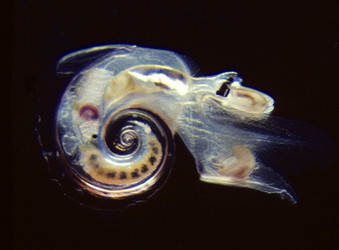
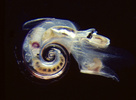

 Go to quick links
Go to quick search
Go to navigation for this section of the ToL site
Go to detailed links for the ToL site
Go to quick links
Go to quick search
Go to navigation for this section of the ToL site
Go to detailed links for the ToL site